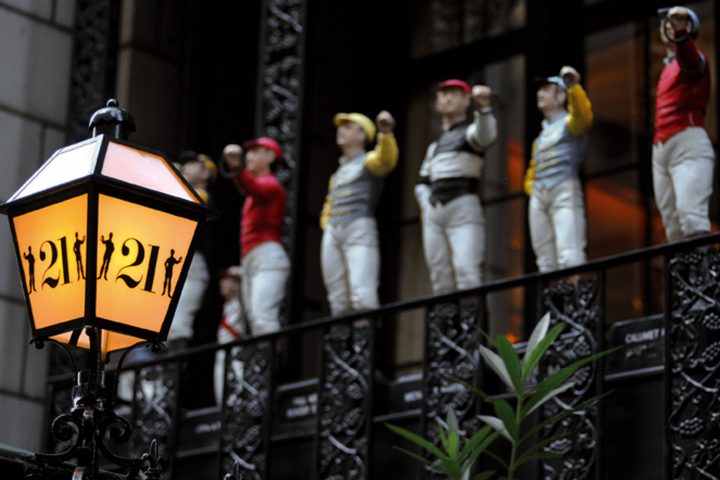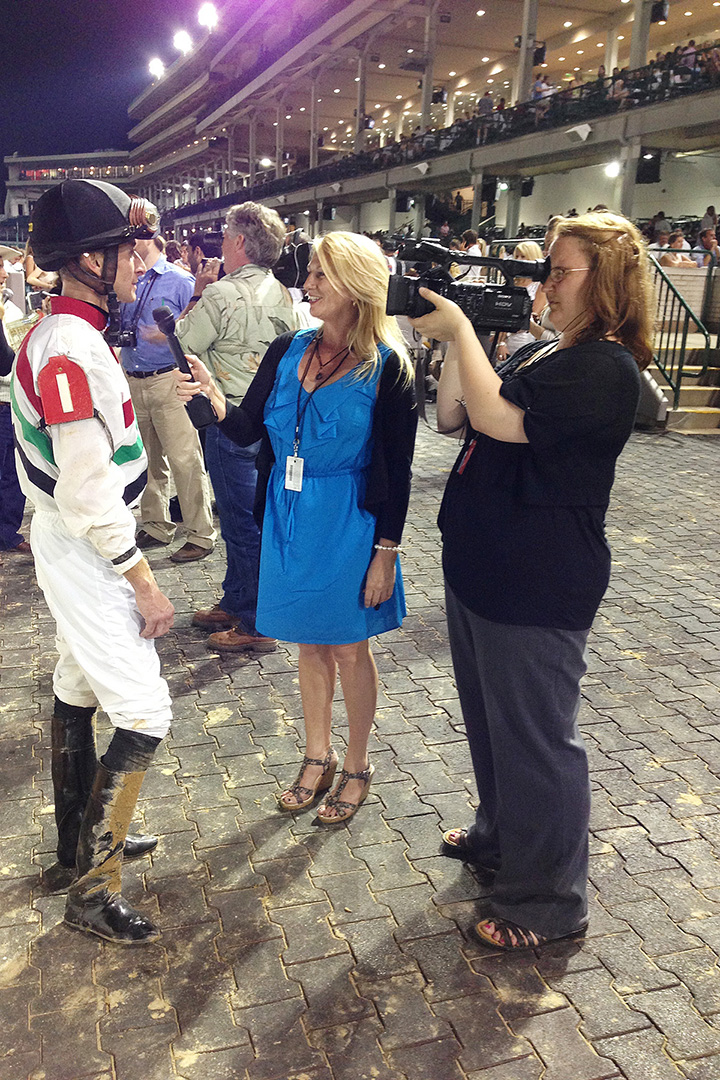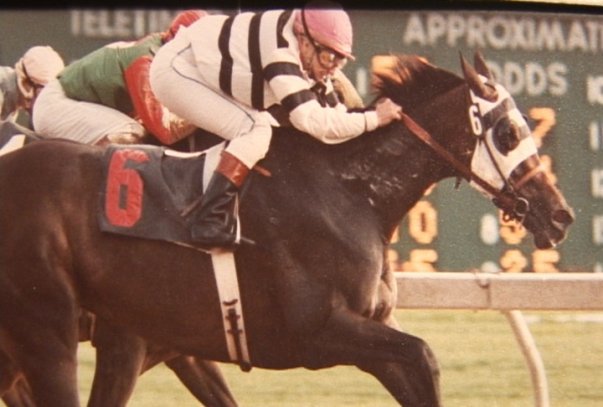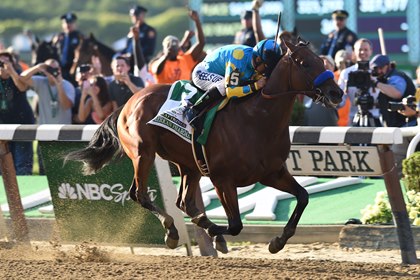Horse Racing
“And they’re off!” Horse racing of all types is found in our racing section, including Thoroughbred, Quarter Horse, Harness, Steeplechase and Arabian racing.
Want to get lucky? Take a look at the Wagering to help guide you. Keep track of upcoming horse races and racing events in our Calendar of Events for Horse Racing.
Want to live the dream of owning a racehorse? Check out the Breeding, Partnerships, Sales & Bloodstocks sections where you can help yourself be a force in the Sport of Kings.
Need a place to train your baby and help develop his successful career? You will find both training facilities and professional racehorse trainers in our Training section. See you in the winners’ circle!
Popular Racing Sites
Horse Racing - General Information
Exaggerator previously lost four races to Nyquist who entered the Preakness Stakes unbeaten. However, Exaggerator turned the tables on Nyquist on the sloppy track at Pimlico Race Course in Baltimore, MD. Longshot Cherry Wine closed well finishing second and nosed out Nyquist who finished third. Interesting note: Exaggerator's sire, Curlin, won the Preakness Stakes in 2007.
Nyquist wins the 142nd Kentucky Derby and remains unbeaten after holding off Exaggerator in second with Gun Runner running third. Watch it again here!

The greatest two minutes are upon us, and we are excited to share Purina’s in-depth profile of American Thoroughbred racehorse trainer Kiaran McLaughlin.
Combining one of the world’s top trainers and many of the world’s best horses – including Derby contender Mohaymen, provides the unprecedented combination of challenges, victories, championships, greatness and powerful nutrition.
Enjoy and share this behind-the-scenes look at Kiaran’s captivating career.
Learn more at Purina Animal Nutrition LLC.

A Triple Crown winner -- and a local artist -- is adding new lustre to the jockeys now standing guard outside NYC's classic '21' Club.
Read the original article on the NY Post here...
On a 94-degree day this July, a heist appeared to happen in broad daylight on West 52nd Street.
One by one, 36 colorful iron lawn jockeys were yanked from their spots outside the iconic ‘21’ Club, where they guarded the doors to the dining room of the city’s cultural, political and business elite.
As six foremen spent four sweaty hours lugging the statues into a moving truck — the smallest jockeys on the stairs weigh 50 pounds, while the largest near the entrance top 200 — they attracted not only scores of passers-by, but the attention of New York’s Finest.
“The NYPD slowed down [to ask] the mover what the heck was going on,” Andrew Tedesco, 45, says.
The jockeys were headed to Tedesco’s home in Montclair, NJ, where the artist is currently putting the finishing touches on an eight-week, major refurbishment of them — marking the first time in the club’s 85-year history that the little iron men have been missing from its facade.
Read more: American Pharoah is now permanently hitched to the ‘21’ Club
American Pharoah edged by 16-1 long shot Keen Ice in Midsummer Derby
By Mark Singelais Updated 12:09 am, Sunday, August 30, 2015
Read the original article on Times Union here...

Saratoga Springs
Triple Crown winner American Pharoah walked down a dirt path back to his barn at Saratoga Race Course on Saturday afternoon, another beaten star at a track long known as the "Graveyard of Champions."
Eduardo Luna, his groom, held his lead shank and a pair of Saratoga Springs police officers followed behind. After a crowd of 50,000 cheered his every move before the Travers Stakes, now only a few onlookers on the backstretch snapped his picture and gave him a smattering of applause.
At 6:36 p.m., American Pharoah and his small entourage passed Barn 27. It's the summer home of trainer Dale Romans, who had just won his first Travers when a 16-1 long shot named Keen Ice passed a tiring American Pharoah in the final sixteenth to win by three-quarters of a length.
Inside his office, Romans slumped back in his leather swivel chair. The heavyset Kentucky trainer wore a white dress shirt that was soaked with sweat from the chest up. He hadn't shown up at the postrace news conference.

Read the original article on Times Union here.
NYRA trumpets appearance, reminds public event is sold out.
By Tim Wilkin Updated 6:37 pm, Sunday, August 23, 2015
American Pharoah is going to run in the Travers Stakes at Saratoga Race Course on Saturday. Trainer Bob Baffert said as much Sunday morning after the first Triple Crown winner in 37 years worked six furlongs in a time of 1:10.98 (by Baffert's stopwatch) at Del Mar Race Track in San Diego.
"He went very well, a real positive move," Baffert said by cellphone as he was watching American Pharoah get his bath following the work. "I needed to see something like that. We have his bags packed (for Saratoga). Right now, everything is set in play. He had to 'wow' me and he did that. I've been looking for an excuse not to come (to the Travers) and I can't find one."
The official word won't come until Monday, after a physical examination shows the horse was not impacted by Sunday's workout. But it looks like it's all but official. The New York Racing Association officially announced the appearance already - along with a reminder that only pre-paid tickets, season ticket holders or those with table reservations will be able to get into the 50,000-plus event.
American Pharoah is scheduled to leave California and fly to Albany International Airport on Wednesday. Baffert said the only possible glitch would be if American Pharoah does not come out of the work in good shape, but he doesn't anticipate that happening.
"He is great today," Baffert said. "As long as he is great (Monday), things look good."
The Travers purse is currently $1.5 million. If American Pharoah is in the starting gate, the value of the race is $1.6 million. The New York Racing Association has put a cap on attendance at 50,000. All tickets for the event are sold out.
There will be no tickets available.

Amanda Roxborough recently spent some time with Equine Info Exchange to share her fascinating journey from jockey to trainer and now an Award Winning video and television producer!
EIE: Amanda, please tell us how your love of horses began? Did you come from a horse loving family or was it your own passion?
AR: I fell in love with horses, and apparently donkeys, at the age of two, on a family outing to Blackpool beach in England [where I was born]. The story goes, that once upon the donkey, I refused to get off and the magical equine connection began. My parents did not have any connection to horses and from that day forward were hounded by my request for a pony.
EIE: How did you become a jockey?
AR: I finally achieved my dream at 11 yrs of age, when after 9 years of begging and many riding lessons, I got a pony. My passion [and obsession] was in full throttle, spending all waking hours at the barn where we boarded my pony.
Two years later my parents bought a small farm with a little barn on it for me to expand and I bought a young ¾ thoroughbred mare as my next horse. In hindsight, it was a crazy decision for a 13 yr old to get a green horse but it was a stamp of my fearless and determined attitude that carried me through my years in the horse business.
After showing hunter and jumper in my teen years, I heard about a summer course at a college in Toronto, a jockey training program. After years of being told by coaches and the odd hunt master [loved hunting with my bold welsh cob} to slow down and that I should go to the race track, I knew my destiny was sealed.
I worked for 7 years with a master Art Warner, who trained for Kinghaven and Sam Son Farms back in the day, he became my mentor. I rode my first race in 1984 at Woodbine racetrack in Toronto Canada.

EIE: Which was your favorite horse you rode as a jockey and why?
AR: I was blessed to ride so many good horses in my years with Mr. Warner, he was training for the Kennedy’s at the time and the barn was full of graded stakes horses.
A colt named Archregent captured my heart, even though he was terror and cheeky to handle. I think my favorite was a mare named Nonna Maria. We won 3 in a row at Woodbine. Another memorable mount was my first winner, a filly named Artistic License. As my life has unfolded I always smile at the irony of her name!
EIE: You trained horses as well, correct?
AR: I rode as a jockey for a short time and went on to become an assistant trainer. I worked with Charley Barley, a champion in Canada and then took out my license and began training a small string. My first win as a trainer was with a filly named Attraction Fatale; she won the Grade 2 Lady Angela stakes at Woodbine.
I loved training horses. Life carried on and I found myself in New York, a mother of a new baby boy and galloping horses for top stables at Belmont Park. One of my favorites was Chief Seattle, a very talented two yr old and Friend’s Lake, winner of the Florida Derby, who ran in the 2004 Kentucky Derby.

EIE:: How did you get involved in your current business Kylar Productions, and creating amazing videos? Tell us how you selected the name "Kylar".
AR: I broke my neck in a morning training accident in Florida one March morning in 2004, and although I healed quickly and continued galloping the rest of that year, I knew I had had a great 26 years in the saddle and it was time to try something new.
Not easy for most of us “racetrackers”, as our job is not a job, it is our passion and finding the next chapter is difficult for most. With many life changes happening at that time, I began writing. To my surprise, I found great solace in writing about the race track and the horses.
As fate would have it, my old friend Mr. Steve Haskin called me to ask about a horse I had ridden and I explained I was no longer working at the track and trying to figure out what I was going to do next. After a wonderful conversation with a man I consider a master of his craft, I was to expect a call from someone he knew at TVG.
My friend Steve had a feeling I might just find my new passion… The call went well, and I was on a plane to Louisville to work for TVG at the Kentucky Derby. After 1 day of being surrounded by creative talented people who loved racing and horses from the “other side”, I was hooked.
I continued to freelance for TV networks, and started doing production work locally in Florida. Kylar Productions is my production media company I started in 2006, named after my son Kyle and my initials AR and it is the result of a lot of hard work and passion, two things I brought with me from my life on the racetrack.
We specialize in TV productions, Web videos, event coverage and Equine Productions, from mainstream business to sports related industries.

EIE: Do you specialize in any type of equine videos?
AR: Equine Production is one of my main passions. With over two decades in the Thoroughbred racing industry, I have the ability to use my expertise in the equine industry and create dynamic and truly organic productions.
I have produced short documentaries that have been instrumental in creating positive changes in the thoroughbred industry and it is my passion to continue to do more.
EIE: What are some special moments when shooting videos or something which moved you emotionally)
AR: I am proud to do work for several non profits for children and animals. I am a very valued based person and giving and making a positive impact makes me very happy.
I have produced several tribute videos for the Belmont Child Care Ass over the years and giving back to the racing community is very important. I have interviewed Bill Parcells and Mike Singletary, two football greats and I loved that…
EIE: What are the greatest challenges?
AR: I produced and hosted a weekly TV show on CSS in the Southeast market, called EquiStarsTV. I put it together and on air, learning as I was going. It was propelled by more guts and hard work than sponsorship, but I learned so much and realized I could make it happen!
EIE: Tell us about your awards and the times when your amazing work was recognized!
AR: I began covering Arabian Racing in 2010 when I was contacted by a friend from Abu Dhabi, who I reconnected with in Dubai [I worked for Sheik Hamden stable in Dubai for 3 years}.
The President’s Cup is a worldwide racing series for Arabian horses and they were coming to the US and I was contracted to cover the race and produce content for their TV and media outlets. In 2013 the Arabians had their first Gr 1 Breeders Cup race. The coverage from those events lead to my nomination for a Darley Award in 2014 - the equivalent to an Eclipse Award in thoroughbred world (photo at left).
The magical event was held in Hollywood, California and I won for best TV Presenter. I was lucky to have been nominated again this year for the 2015 Darley. It is important to me to do a good job and my work is a reflection of my heart and passion for life.
EIE: Where can we see your work?
AR: My website www.KylarProductions.com and my YouTube channel Kylar Productions.
EIE: Tell us about your next project.
AR: I am busy producing work for main stream businesses as well equine projects. I am working on a documentary that I hope to submit to the Equine Festival in NY in the fall. I also do PR media training and coaching for clients. I am always open to creating!
You can find more interesting articles in our section on Racing & Wagering.
Are you interested in promoting your business or sharing content on EIE? Contact us at info@equineinfoexchange.com

Courtesy of thehorse.com - Read the original article here... American Pharoah became Thoroughbred racing's 12th Triple Crown winner June 6 with a victory in the 2015 Belmont Stakes.
Photo: David Alcosser/NYRA
On an idyllic Saturday evening at Belmont Park, American Pharoah made it worth the 37-year wait.
Under a perfectly calculated ride by Victor Espinoza, the son of Pioneerof the Nile led the field from start to finish in the Grade 1 $1.5 million Belmont Stakes, drawing away in the stretch to become the first Triple Crown winner since Affirmed in 1978 and end a drought that had seen the hopes of 13 Kentucky Derby and Preakness Stakes winners end in disappointment.
"He's [American Pharoah] obviously the real deal. He's the best three-year-old at this point, but the reason they call this the Test of Champions. . .it's a mile and a half and it's always a test, and you know, there's some nice horses that will be testing him." - Steve Cauthen, Jockey on Affirmed
Article courtesy Thorofan
The thirty-seven year drought in Triple Crown winners raises many questions about racing, breeding and training. Most experts believe the drought has been caused by breeding practices where the market driven sport is more about speed than endurance. With the growth of partnerships, ownership has shifted from the wealthy to the average fan who hopes to make a profit or at least break even. That was not the goal of the wealthy owners who did it for the sport.
If we believe breeding is the culprit, we have to explain the strange pattern in Triple Crown winners. The 1930s had three --Gallant Fox (1930), Omaha (1935) and War Admiral (1937). The 1940s has four -- Whirlaway (1941), Count Fleet (1943), Assault (1946) and Citation (1948). Then came a two decade drought --1950-60s. The explanation of breeding and form of ownership doesn't easily explain this pattern.
- New Sgt. Reckless Race Comes to Pimlico for Preakness Week
- Ilka Gansera-Leveque: "You Can Watch This!"
- Wagering on Horse Racing in Australia
- Wagering on Horse Racing in the United States
- Wagering on Horse Racing in France
- Wagering on Horse Racing in Germany
- Wagering on Horse Racing in Gibraltar
- Wagering on Horse Racing in Ireland
- Wagering on Horse Racing in South Africa
- Wagering on Horse Racing in the United Kingdom









